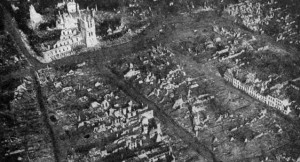Asiago is a small alpine town (1001 m elevation) with a population of less than 7.000 inhabitants. It is the main settlement on the Sette Comuni upland, also called Asiago upland. In 1916 it had more or less the same size of today. On the 15th of May the city was stroken by heavy artillery fire: on that very day the Austro-Hungarians started what would later be known as “Trentino offensive“. The italian officer Attilio Frescura was an eye witness of the destruction of Asiago. He reports that an enemy airplane started scouting and signaling from 5:00 a.m., and at 7:00 the first shot hit the city. Frescura also saw women and children among the casualties.
The Trentino offensive, known in Italy as “Strafexpedition”, was ordered by general Franz Conrad von Hötzendorf. He thus hoped to reach Venice and outflank the Italian divisions fighting on the Isonzo, forcing Italy to surrender. On the 4th of June a violent Russian offensive on the eastern front forced the Austro-Hungarian high command to withdraw troops from Italy in order to send reinforcements in Galicia. The offensive could no longer be sustained.
The war journal of Attilio Frescura has been published under the ironical title: “Diario di un imboscato” (journal of a draft dodger). It is available in PDF format at http://teca.bncf.firenze.sbn.it/ImageViewer/servlet/ImageViewer?idr=BNCF00004006672#page/14/mode/1up

British captain Howard B. Ward served in northern France and Belgium. In 1982 he was recorded while sharing war memories in a classroom. In the selected fragment (set in 1917) he recalls the devastation of Ypres, a Belgian town stuck between the Brtitish and the German lines. According to him the ruins grew layer after layer, almost reaching the level of the bell tower: “You could just see the top of the tower sticking out of the ground”. The statements of Howard Ward might be exagerated (see the picture), but the Ypres salient stood in a key position and was the center of bitter fightings from the beginning to the end of the war. The full tape is available at: http://www.europeana.eu/portal/record/2020601/attachments_66347_4980_66347_original_66347_mp3.html?
Walter Flex was a German soldier on the Western front, his unit was deployed in north-eastern France. While fighting in the village of Seuzey he withnessed a fire that destroyed the village church. In a letter to his parents dated 4. Februar 1915 he makes a dreadful account of the events, and lingers more than once on the image of the holy ruin. His letter, together with many others, is available at: https://www.thueringen.de/imperia/md/content/lzt/quellen_feldpost_32.pdf
-Credits-
Editing: Eva Schmidhuber, Matteo Coletta
Voices in this episode: Matteo Coletta as Attilio Frescura, Howard B. Ward as himself, Norbert K. Hund as Walter Flex. A special thank you goes to Norbert, who found the letter of Walter Flex.
Jingle:
Music: Gregoire Lourme, “Fire arrows and shields”
Concept: Matteo Coletta
Voices: Hannes Hochwasser, Matteo Coletta, Roman Reischl, L.J. Ounsworth, Norbert K. Hund.
